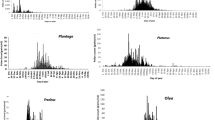Abstract
The present study disclosed the cross-reactivity between Bermuda grass pollen (BGP) and other grass pollens using monoclonal antibodies (MAbs) and polyclonal antiserum. MAb 9–13, directed against a group of minor allergens of BGP (Cyn d Bd68K, 48K, 38K) was found to cross-react with extracts of ten other grass pollens. Immunoblotting assays illustrated that MAb 9–13 cross-reacted with multiple components of most of these pollens, and the major cross-reactive components had molecular weights of 29–36 kD. The cross-reactivity between BGP andLol pI, the group I allergen of rye grass pollen, was further evaluated;Lol pI was recognized by MAb 9–13, but not by our MAbs/polyclonal antiserum againstCyn dI, the major allergen of BGP. These results suggest that the epitope recognized by MAb 9–13 is a common (C) epitope shared byLol pI andCyn d Bd68K, 48K, 38K, andCyn dI does not share significant antigenicity withLol pI. In a modified radio-allergosorbent test, IgE antibodies in the serum of BGP-allergic patients reacted mildly with C-epitope-bearing components of both BGP and rye grass pollens, and this binding could be blocked specifically by MAb 9–13. This suggests that in addition to an antigenic cross-reaction, the C epitope can also lead to an allergenic cross-reaction.
Similar content being viewed by others
References
Aalberse RC. Clinically significant cross-reactivities among allergens. Int Arch Allergy Immunol 99:261–264;1992.
Aalberse RC, Koshte V, Clemens JGJ. Immunoglobulin E antibodies that crossreact with vegetable foods, pollen, and Hymenoptera venom. J Allergy Clin Immunol 68:356–364;1981.
Bose R, Rector ES, Fischer J. Production and characterization of mouse monoclonal antibodies to allergenic epitopes onLol pI (Rye I). Immunology 59:309–315;1986.
Bradford MM. A rapid and sensitive method for the quantitation of microgram quantities of protein utilizing the principle of protein-dye binding. Anal Biochem 72:248–254;1976.
Chang HN, Lin FM, Chang YF. Correlation of skin test to RAST, and PRIST in asthma patients. Clin Med J 34:376–383;1984.
Chang ZN, Chang LD, Wang MC, Tsai LC, Ling CY, Chi CW, Han SH. Monoclonal antibodies specific for human IgE and their clinical applications. Proc Natl Sci Counc Repub China B 12:140–145;1988.
Chang ZN, Chi CW, Sun HF, Tsai LC, Lee DT, Han SH. A unique human IgE-binding epitope on the Bermuda grass pollen recognized by mouse lambda-type monoclonal antibodies. Clin Exp Allergy 21:503–509;1991.
Chang ZN, Tsai LC, Chi CW, Wang MC, Shen HD, Lee DT, Han SH. Analysis of allergenic components of Bermuda grass pollen by monoclonal antibodies. Allergy 46:520–528;1991.
Esch RE, Klapper DG. Cross-reactive and unique grass group I antigenic determinants defined by monoclonal antibodies. J Allergy Clin Immunol 79:489–495;1987.
Han SH, Chang ZN, Chi CW, Perng HJ, Liu CC, Tsai JJ, Tam MF. Using monoclonal antibodies to isolate and characterizeCyn dI, the major allergen of Bermuda grass pollen. J Allergy Clin Immunol;in press.
Han SH, Shieh ZF, Tsai LC, Juang WC. The anemophilous plant and its pollens in Taipei. J Chin Microbiol Immunol 13:174–182;1980.
Kahn CR, Marsh DG. Monoclonal antibodies to the majorLolium perenne (rye grass) pollen allergenLol pI (Rye I). Mol Immunol 23:1311–1318;1986.
Laemmli UK. Cleavage of structural proteins during the assembly of the head of bacteriophage T4. Nature 227:680–685;1970.
Leiferman KM, Gleich GJ. The cross-reactivity of IgE antibodies with pollen allergens. I: Analysis of various species of grass pollens. J Allergy Clin Immunol 58:129–139;1976.
Lin Z, Ekramoddoullah AKM, Jaggi KS, Dzuba-Fischer J, Rector E, Kisil FT. Mapping of epitopes onPoa pI andLol pI allergens with monoclonal antibodies. Int Arch Allergy Appl Immunol 91:217–223;1990.
Lin Z, Ekramoddoullah AKM, Kisil FT, Hebert J, Mourad W. Isolation and characterization ofPoa pI allergens of Kentucky bluegrass pollen with a murine monoclonal anti-Lol p antibody. Int Arch Allergy Appl Immunol 87:294–300;1988.
Marsh DG, Haddad ZH, Campbell DM. A new method for determining the distribution of allergenic fractions in biological materials: Its application to grass pollen extracts. J Allergy 46:107–121;1970.
Martin BG, Mansfield LD, Nelson HS. Cross-allergenicity among the grasses. Ann Allergy 54:99–104;1985.
Matthiesen F, Schumacher MJ, Lowenstein H. Characterization of the major allergen ofCynodon dactylon (Bermuda grass) pollen,Cyn dI. J Allergy Clin Immunol 88:763–774;1991.
Merril CR, Goldman D. Detection of polypeptides in two-dimensional gels using silver staining. In: Celis JE, Bravo R, eds: Two-dimensional Gel Electrophoresis of Proteins: Methods and Applications. New York, Academic Press, 111–126;1984.
Meyer RL, Berns-Mason AW, Thayer KH, Feldman BH, Rosengren HN. Isolation and characterization of the dialysate from Bermuda grass pollen. J Allergy 47:100–101;1971.
Mourad W, Mecheri S, Peltre G, David B, Hebert J. Study of the epitope structure of purifiedDac gI andLol pI, the major allergens ofDactylis glomerata andLolium perenne pollens, using monoclonal antibodies. J Immunol 141:3486–3491;1988.
Mourad W, Pelletier G, Boulet A, Islam N, Valet JP, Hebert J. Allergenicity and cross-reactivity of rye grass pollen extracts revealed by monoclonal antibodies. J Immunol Methods 89:53–59;1986.
Mucci N, Liberatore P, Federico R, Forlani F, Di Felice G, Afferni C, Tinghino R, De Cesare F, Pini C. Role of carbohydrate moieties in cross-reactivity between different components ofParietaria judaica pollen extract. Allergy 47:424–430;1992.
Schumacher MJ, Grabowski J, Wagner CM. Anti-Bermuda grass RAST binding is minimally inhibited by pollen extracts from ten other grasses. Ann Allergy 55:584–587;1985.
Singh MB, Knox RB. Grass pollen allergens: Antigenic relationships detected using monoclonal antibodies and dot blotting immunoassay. Int Arch Allergy Appl Immunol 78:300–304;1985.
Standring R, Spackman V, Porter SJ: Distribution of a major allergen of rye grass(Lolium perenne) pollen between other grass species. Int Arch Allergy Appl Immunol 83:96–103;1987.
Sward-Nordmo M, Smestad Paulsen B, Wold JK. Immunological studies of the glycoprotein allergen Ag-54 (Cla hII) inCladosporium herbarum with special attention to the carbohydrate and protein moieties. Int Arch Allergy Appl Immunol 90:155–161;1989.
Trinca JC. Pollens used in the treatment of hay fever and asthma in eastern Australia. Med J Aust 49:969–972;1962.
Author information
Authors and Affiliations
Rights and permissions
About this article
Cite this article
Chang, Z.N., Liu, C.C., Perng, H.C. et al. A common allergenic epitope of Bermuda grass pollen shared by other grass pollens. J Biomed Sci 1, 93–99 (1994). https://doi.org/10.1007/BF02257982
Received:
Accepted:
Issue Date:
DOI: https://doi.org/10.1007/BF02257982



